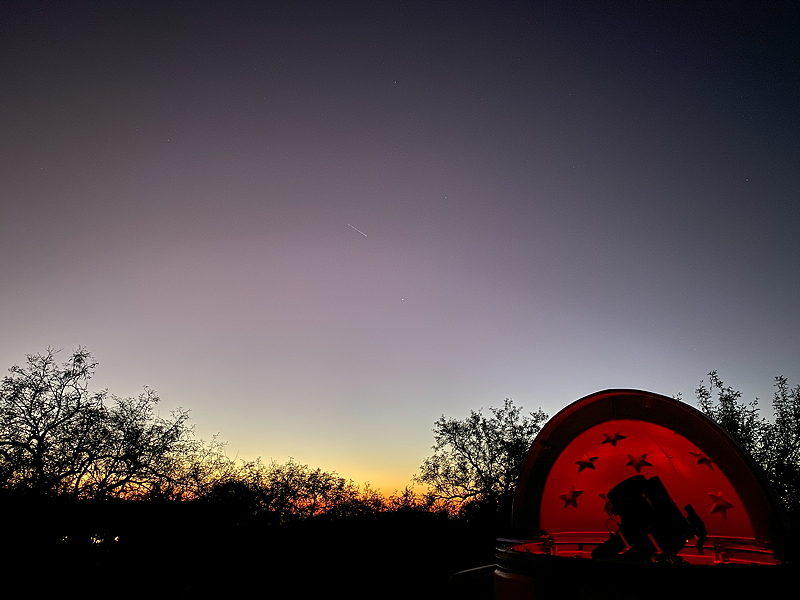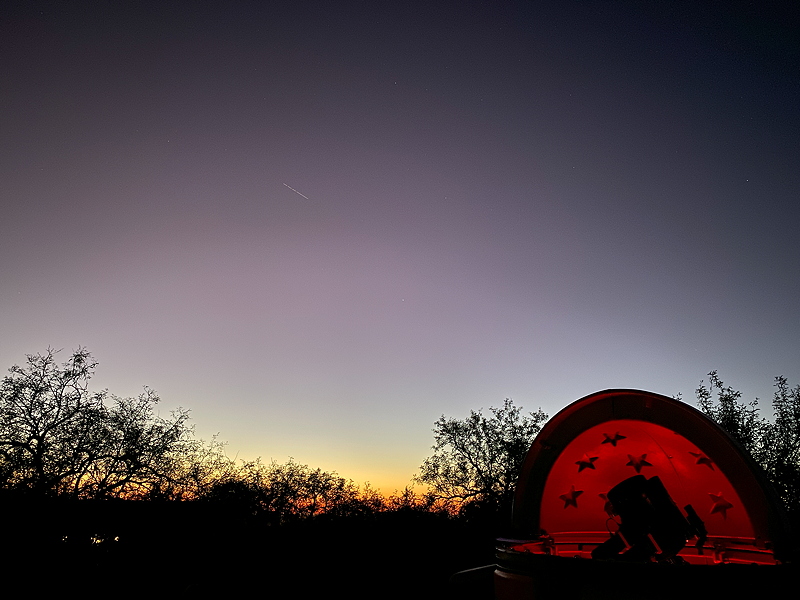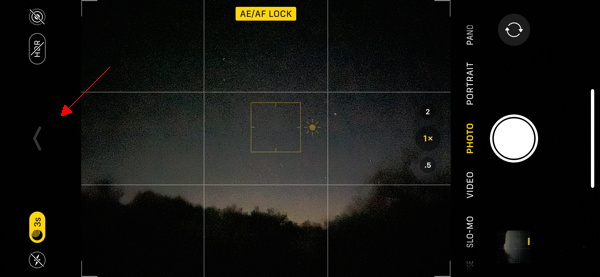iPhone 11 Pro Max Night Mode tests: ISS, Sky;
Owl
Posted: 13 October 2019
The sky was clear Friday evening, 11 October 2019. However, after installing a replacement kitchen appliance during the day I didn't feel up to going out.
|
Open: Saturday, 12 October 2019, 1741 MST Temperature: 91°F |
Session: 1394 Conditions: Clear |
Equipment Used:
12" f/8 LX600 w/StarLock
2" 24mm UWA eyepiece
1.25" 9mm eyepiece
1.25" 2X Barlow Lens
Atmospheric Dispersion Corrector
Camera:
iPhone 11 Pro Max
D7200 DSLR
After opening the observatory I set up the iPhone 11 Pro Max on a tripod using the Levenhuk Smartphone Adapter.

I planned to photograph a pass of the International Space Station (ISS) using the iOS Camera app "Night Mode". While waiting for the pass to start I relaxed on the observatory patio bench.
1755 MST: sunset.
The ISS pass, which started at 1831 MST, occurred during twilight so the sky was still somewhat bright. Here are two photos of the ISS (the streak) in the western sky.


This Night Mode photo shows the ISS near the Sagittarius "Teapot", with the planets Saturn (left) and Jupiter (right).

From these tests it is clear that the new iOS Camera "Night Mode" will be good for photographing passes of the International Space Station.
Just before the ISS pass, a Great Horned Owl landed in a tree near the observatory. After the pass ended the owl was still there and I managed to get this photo (cropped) with a D7200 DSLR.

1849 MST: LX600 ON, StarLock OFF, High Precision OFF.
Viewed Saturn and three moons, 102X.
On my previous report I mentioned that once Night Mode was used you could not get back to the video modes without quitting the app. I was wrong. There is an "arrow" at the top or left of the Camera app screen that toggles between modes, as seen in this screen shot.

I took this handheld Night Mode photo of the Milky Way in a Moonlit screen.

The photo is very close to how the sky looked. I am looking forward to photographing the Milky Way with Night Mode without the Moon in the sky.
When Night Mode is used an exposure selection slider appears at the bottom or right of the screen and the toggle arrow reverses. Tapping the arrow shows the camera modes selector again.


I then mounted the iPhone with the Earbuds as a remote shutter release on a 9mm eyepiece + Atmospheric Dispersion Corrector.

I used the iPhone Camera app slo-mo (240fps) video recording mode to image Saturn, afocal 271X. Seeing was not very good. This is a stack of 2500 video frames.

I added a 2X Barlow Lens for a magnification of 542X but that was too much for the seeing conditions.
I then set up for some more Night Mode sky photography with the iPhone 11 Pro Max on the camera tripod. I used the Phone Skope Bluetooth Shutter Remote to take the photos. The top photo shows me relaxing and viewing the Moonlit sky. The bottom photo shows the constellation of Cassiopeia over Cassiopeia Observatory. The Double Cluster is even visible in the bottom photo between Cassiopeia and Perseus.


The iOS Camera app in iOS 13 with Night Mode is going to be fun to use once Moon is gone from the sky. The app may automatically set the exposure to 3 seconds but using the slider (and depending on the scene darkness) you may be able to get exposures up to 28 seconds (which is the maximum I've seen so far).
I took a quick look at the Moon, 102X. A very slight terminator was visible.
1954 MST: LX600 OFF.
|
Close: Saturday, 12 October 2019, 2002 MST Temperature: 67°F |
Session Length: 2h 21m Conditions: Clear |
I have posted my review of the ScopeStuff Dovetail Bar for ETX Models. If you have an ETX telescope and want to defork it to mount on a GEM or other Vixen dovetail mount, check it out.
Comments are welcome using Email. Twitter users can use the button below to tweet this report to their followers. Thanks.
Cassiopeia Observatory Home Page
Copyright ©2019 Michael L. Weasner / mweasner@me.com
URL = http://www.weasner.com/co/Reports/2019/10/13/index.html
